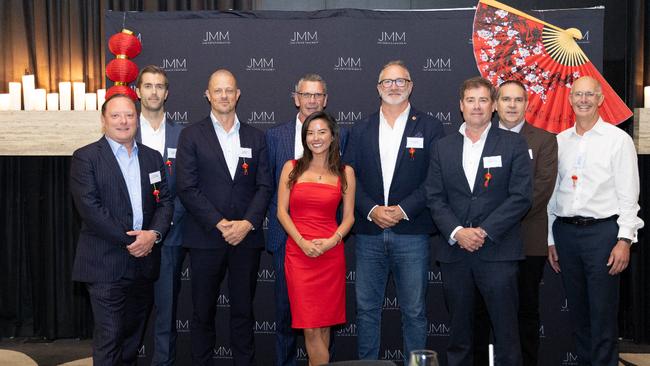JMM welcomes Year of the Snake with main course of diverse ASX companies
Jane Morgan Management’s Chinese New Year feast showcased emerging ASX companies to investors. Now you can get the inside scoop too.

Stockhead
Don't miss out on the headlines from Stockhead. Followed categories will be added to My News.
Special Report: In the Chinese world, those born in the Year of the Snake are marked by their resilience and courage. That was on full display as Jane Morgan Management ushered in the Chinese New Year with a luncheon on January 31 that connected investors with some of the most enterprising small caps on the ASX.
- Emerging companies connected with investors at Jane Morgan Management’s Lunar New Year lunch
- Rapid fire presentations gave CEOs opportunity to showcase companies
- Resources, finance and technology stocks stole the show
The festivities mark the beginning of the Lunar calendar year and the Year of the Snake, a time of transformation, wisdom, and personal growth according to Chinese astrology.
The main course was a lineup of emerging ASX listed resources, finance and technology companies covering precious metals like gold, to energy, financial services, AI and agriculture.
Barton Gold (ASX:BGD) – Australia’s next near-term gold producer
Managing Director: Alexander Scanlon
It’s a good time to be in gold, with futures raging past US$2900 or almost A$4650 an ounce today.
Barton is closing in on plans to deliver 150,000oz of annual gold production at its ~1.6Moz Tunkillia and Tarcoola projects in South Australia’s Central Gawler Craton from 2026, owning one of the only gold mills in the region.
“Our strategy has been to step back and build up a dual development platform where we are focusing on developing long-term, large-scale gold production, but also leveraging our existing infrastructure to short-term operations using remnant mineralisation we have around that asset,” Scanlon said.
Barton wants to emulate the success of Capricorn Metals, now a $3.3bn company after developing its low grade 120,000ozpa Karlawinda mine in WA’s Pilbara.
A scoping study drills deeper into that uncanny likeness, saying Tunkillia could produce 130,000ozpa of gold and 300,000ozpa of silver at an all-in sustaining cost of A$1900/oz. But that’s just scratching the surface.
“There’s two critical things here, one is economies of scale, so the horsepower you get out of a mill that’s 5Mt per annum, and two is the torque that you can get out of the same mill,” Scanlon said.
“We have a central higher grade zone which is essentially a higher grade starting pit, so instead of producing 130,000oz for our first year, we produce 180,000oz.
“What that means is we have gross free cash flow of about $400m from the starter pit. So we have a very, very fast return of capital and then we are in to dividend-able income very, very quickly.
And that’s only based on about 60% of the resource, which would deliver a very decent 40% equity IRR and a 1.9 year payback. An optimised scoping study is now underway.
WT Financial Group (ASX:WTL) - Targeting $4tn superannuation sector
Managing director: Keith Cullen
Since the Royal Commission decimated the financial services sector in 2018, WT Financial Group has carved itself a sweet slice of the market – in Cullen words “taking a bunch of money and running into a burning building”. But, that gamble paid off.
The company is now one of the largest financial advisor networks in Australia, with 400 privately-owned advice practices whose advisers operate as authorised representatives under its Wealth Today, Sentry Advice, Synchron Advice and Millennium3 subsidiaries.
WTL holds the licences and takes a commission from sales (around 4.8%), charges base service fees and – most importantly – has exposure to the $4 trillion superannuation market just as Australia’s baby boomers approach retirement.
“We saw an opportunity in the wake of the Royal Commission, that set us on the path from originally being a retail-focused business to being an acquirer of these advice networks,” Cullen said.
“Last year, we did $180 million in revenue, and our net revenue was around $18 or $19 million. So, we're running at around a 25% to 30% EBIT ratio of our net revenue.
“A unique thing for a micro-cap is that we're profitable.
“We paid a half-cent dividend late last year and have adopted a policy of paying dividends twice yearly.”
A few years ago, there were 25,000 licensed advisors in Australia, now there are about 15,500 and barriers to entry are incredibly high with new education standards requiring a specific degree – which only 400-500 people graduate with per year.
What that means is there’s an enormous supply-demand gap for licenced advisors – and the market opportunity is huge.
“Meanwhile, superannuation assets have exceeded $4 trillion, with net superannuation asset growth surpassing $2 billion a week,” Cullen said.
“We see massive revenue upside through the supply-demand imbalance.”
QPM Energy (ASX:QPM) – Cornering the Queensland gas market
CEO: David Wrench
The energy company has cornered the Queensland gas market, owning the Moranbah gas project which produces around 30TJ/day.
QPM is also connected to five operating coal mines, collecting gas from their operations which would otherwise be waste, making the company a carbon abatement business too.
And they operate two gas-fired power stations which service the Queensland grid – a volatile market that has seen the price go from negative to over a ridiculous $7500 per megawatt hour.
“In the December quarter, we turned over just over $30 million,” Wrench said.
“We produced and supplied about 2.5 petajoules of gas, and we ended the quarter with about $23 million in cash.”
The gas production asset also has a substantial reserve position—about 330 petajoules of 2P reserves.
“To put that in context, we produced 2.5 petajoules in the last quarter,” Wrench said. “At this rate, we could operate for about 130 quarters.”
About two-thirds of the company’s gas is delivered to 18% shareholder Dyno Nobel, which produces ammonium nitrate and explosives for the coal mines in Moranbah and also finances QPM with an $80m development funding facility in return for gas.
The other third goes to power generation, with the company’s Moranbah and Townsville power stations generating 170-180 megawatts of power to Queensland during peak periods.
“Solar dominates the daytime, leading to very low or even negative power prices, but as the sun sets and people turn on their air conditioning, there’s a huge supply-demand imbalance, leading to extreme price volatility,” Wrench said.
“In the last quarter, this revenue stream generated about $20 million from just one-third of our gas supply.”
RocketBoots (ASX:ROC) – Streamlining retail and banking with AI
CEO: Joel Rappolt
RocketBoots’ SaaS AI platform enables retailers and retail banks to reduce staffing costs and loss-prevention while simultaneously improving customer service outcomes.
Globally, it’s a $2.4bn addressable market across Australia, New Zealand, UK, EU and US and Rappolt says RocketBoots could grow further by installing additional modules into the software offering.
“As a software business, it’s quite often difficult to get revenue but we’re happy to say that we are at over $1m in revenue, we’ve got four major contract customers, two of which have been with us for over five years,” he said.
Amongst its four major customers are three multinationals that run across multiple countries, including a retail grocery business that’s operated out of Europe.
The return on investment for that grocery chain across its stores globally is up to 20x.
And the product can be scaled rapidly, as the cloud platform allows the company to operate the software from its Sydney offices without ever having to attend a customer site. Each site achieves a between $3000-$3500 licensing fee.
With retail banks, the company can unlock underutilised staff time in the branch and repoint that time to more valuable transactions for the bank.
New Murchison Gold (ASX:NMG) – Gold developer backed by $3bn major
CEO: Alex Passmore
New Murchison Gold is another gold developer welcoming record prices, which bode well for its future trajectory as a producer in Western Australia within the next six months.
The company holds a substantial package of historic tenements in the prolific Murchison goldfield near Meekatharra, with a focus on the 677km2 Garden Gully gold project and its Crown Prince deposit. That promises to deliver a substantial 60,000ozpa over a 2.5-year mine life.
NMG recently delivered a feasibility study for Crown Prince, highlighting pre-tax cash flow of $226m (undiscounted) over a period of 30 months at recent spot gold prices (A$4385/oz).
“For every $100 an ounce move in the Aussie dollar gold price, our project, which is a two-and-a-half-year open pit in Western Australia, sees cash flow changes by $11 million,” Passmore said.
It’s all thanks to the discovery two years ago of the Southeastern Zone, just a few hundred meters from historical mineralisation at Crown Prince, which is shallow, starts at surface and hosts around 4g/t gold. That resource stands at 280,000 ounces.
“We’ll be mining around half of that—140,000 ounces—in an open pit to start with and then looking to go underground beyond that,” Passmore said.
The company also has a deal with nearby $3bn gold miner Westgold to treat their gold at the Bluebird mill, with the major also an investor in the company, holding 18%, and sharing in the milling cost and upside.
RLF AgTech (ASX:RLF) – Plant nutrition player with near-term profitability
Acting managing director: Gavin Ball
RLF is an Aussie-based crop nutrition technology company that produces over 50 products for commercial agriculture, enabling farmers to enhance yields by 20-30% and improve produce quality.
Operating in Asia since 2006, the company recently expanded in Australia by acquiring LiquaForce – a liquid fertiliser business in Queensland – allowing it to directly operate, manufacture, and sell its products in the domestic market. That is forecast to deliver $12m revenue this financial year.
Combine that with the $11m and $2m revenue predicted in China and Vietnam respectively and acting MD Ball says you have a very compelling company with long term fundamentals set to achieve $25m revenue for FY25.
“We have a very clear pathway to near-term profitability, and we have forecast growth rates of 66% per year over the next three years,” he said.
And let’s not forget, specialty fertilisers represent a huge $40bn market globally, with Australia alone slated for 200-230% growth over the next three years.
The company’s products can increase crop yields typically between 10% and 30%, help improve the food quality, the nutrient density within the produce, and provide famers with a solid return on investment to boost farm profitability.
The company also has a RLF Carbon branch, which completely integrates into current farm practices so that growers and commercial farmers will be able to generate ACUs in the normal process of just growing food.
Once the proof is in the pudding, profitability is expected to follow, Ball said.
Identitii (ASX:ID8) – Banking software with $190tn addressable market
CEO and managing director: John Rayment
In an age of cyber-attacks and financial fraud, the Aussie software company has found its niche specialising in the banking sector, ensuring organisations can securely share personal information internally and externally with regulators, auditors and third parties.
It’s a massive market, with approximately $190 trillion moving cross-border last year. And that’s a number which is forecast to grow to $290 trillion in the next seven years.
The company has customers like MasterCard, Rabobank, and Australia's Bendigo and Adelaide Bank (along with a couple of payments businesses) and the platform is already live and working in the United States, Australia, and New Zealand.
But what’s really interesting is that ID8 has picked a fight with one of the biggest banks in the world – JP Morgan – filing a promising claim for patent infringement in the United States courts.
A patent allows you to identify another company or business using your invention and ask them to recognize that you were first with the idea and pay a reasonable royalty. In other words, they could be compelled to give you money for using your idea.
“In our case, we believe that JP Morgan in the United States is using our idea,” Rayment said.
“But what makes this case different is that we believe we can prove that we actually gave it to them.”
In 2016, ID8 participated in a global compliance challenge held by SWIFT, the organisation that reconciles all interbank transfers worldwide. They won the challenge with their idea of using a blockchain token inside a SWIFT message so that banks could send blockchain tokens to each other (which would hold an infinitely large amount of information) helping to verify buyers, directors, and other required details.
“As a function of winning the trial, we were given nine banks to conduct a proof of concept with – one of them was JP Morgan,” Rayment said.
After sharing their idea with the bank, JP Morgan left the trial and a short time later launched the Interbank Information Network, which ID8 believes is its idea repackaged.
The U.S. Patent & Trademark Office certainly thinks the company has a claim, recently denying a petition from JP Morgan to invalidate Identitii’s patent.
RooLife Group (ASX:RLG) – Exposure to high growth Asian e-commerce markets
CEO: Bryan Carr
RLG has carved out a slice of the enormous Chinese market – and appetite – for Australian health and wellness products with its e-commerce platform.
“We selected China as a key market for us because it is the largest e-commerce market in the world,” Carr said.
“It has a very sophisticated, mature infrastructure for delivering products into market, it's a very quick way to enter into the market and leverage the high regard that Australia and Australian products are held.”
RLG connects brands with consumers using well-known international platforms like Douyin (TikTok) and WeChat, as well as through its own innovative digital platform – RLG Marketplace – which connects new market entrants with on-the-ground support.
It’s certainly bringing cash through the door, with RLG launching three new online stores over the last quarter into three new markets – China, Hong Kong and Australia – which has driven revenue up 144% on the previous quarter.
The company has now expanded its international presence by launching its Australian Pavilion on JioMart, India's largest retailer, as well as introducing high-margin own-brand products in the health and wellness space, including its own milk powder, honey and health supplements.
It’s a sector in India that’s growing at about 165% per year, with Australia entering into a promising free trade agreement with the country.
“Australian products will progressively become tax-free in India in a market that traditionally has high tariffs, so the opportunity for Australian products to leverage and enter into that market right now has never been as good as it is now and will increasingly be a great opportunity for Australian products and brands,” Carr said.
On the revenue front, RLG has increased profit margins consistently over the last four quarters, and reported revenue last year of $10m.
This article was developed in collaboration with Jane Morgan Management, a Stockhead advertiser at the time of publishing.
This article does not constitute financial product advice. You should consider obtaining independent advice before making any financial decisions.
Originally published as JMM welcomes Year of the Snake with main course of diverse ASX companies


